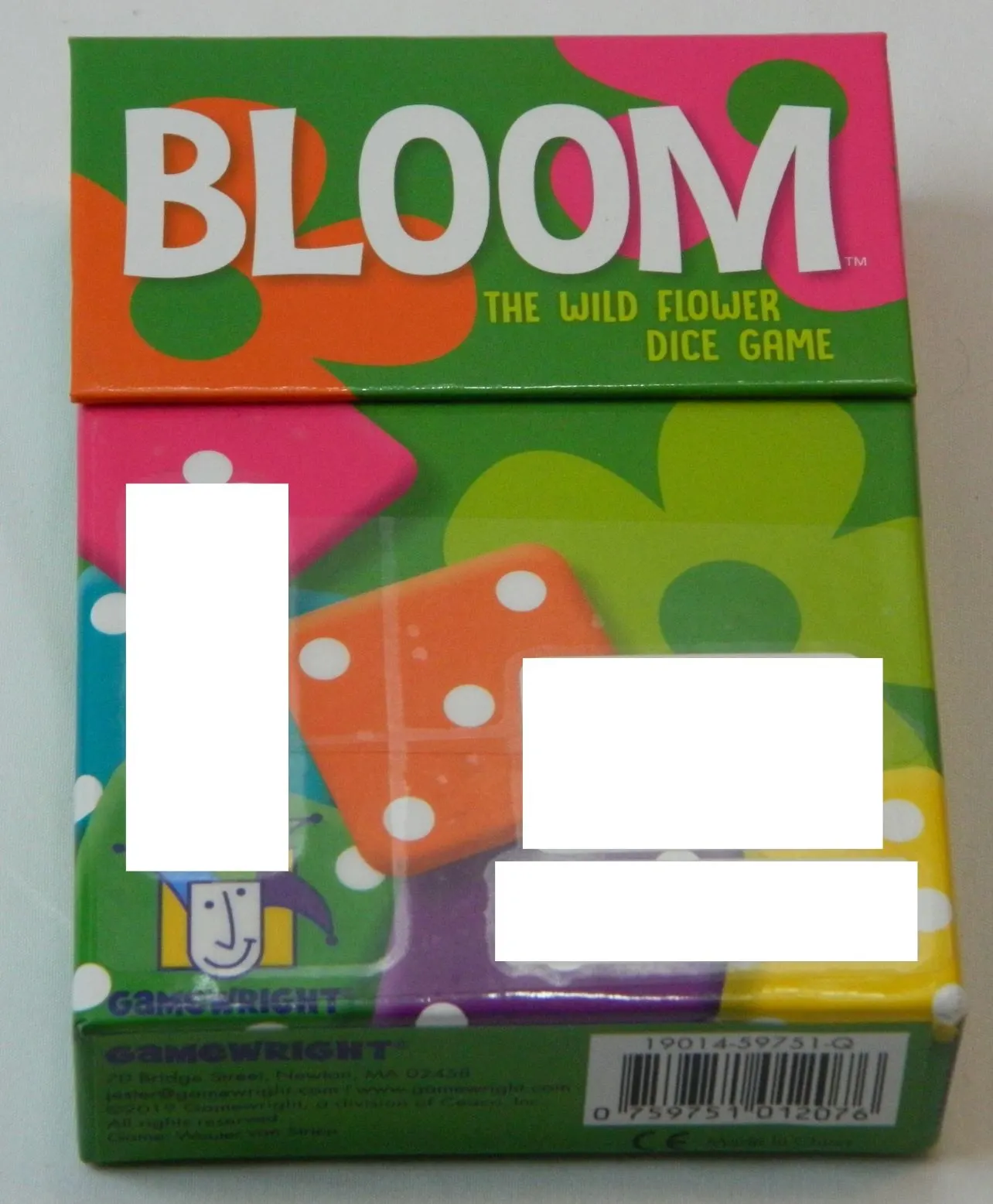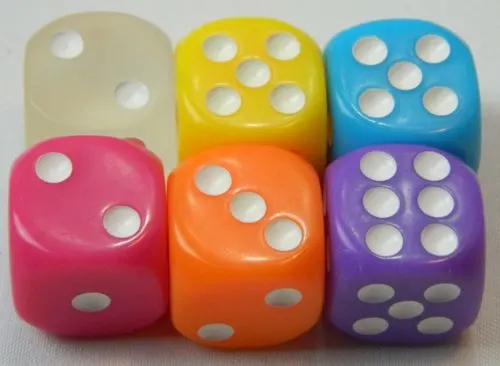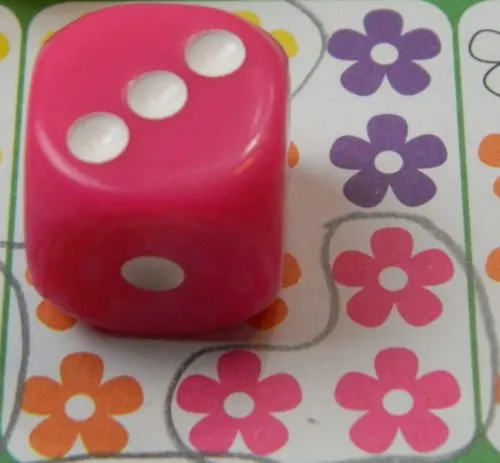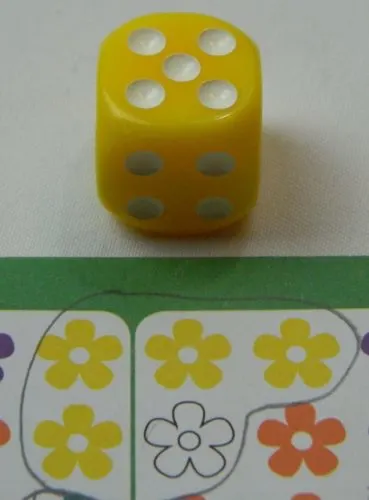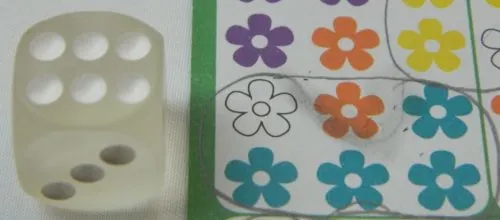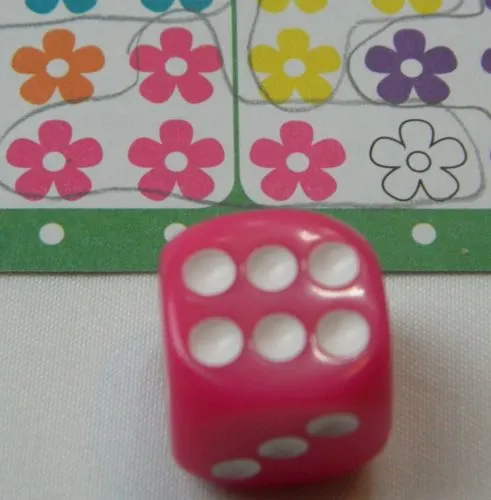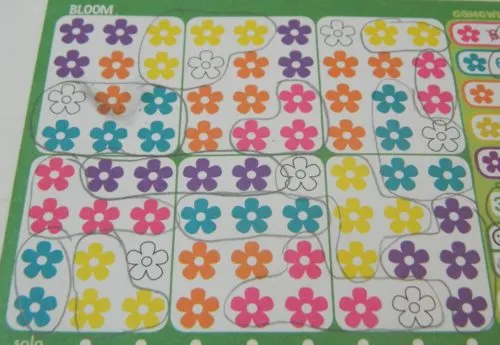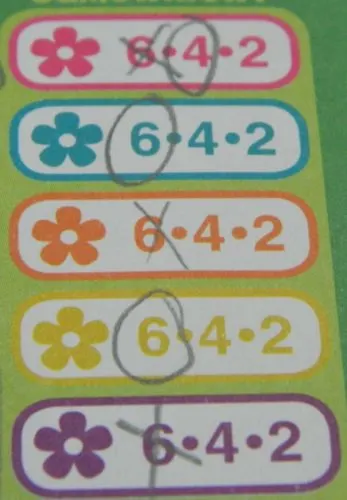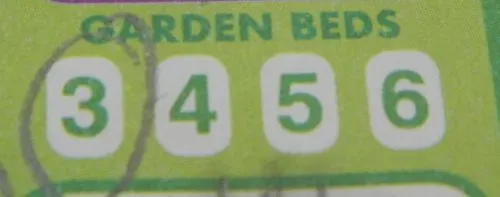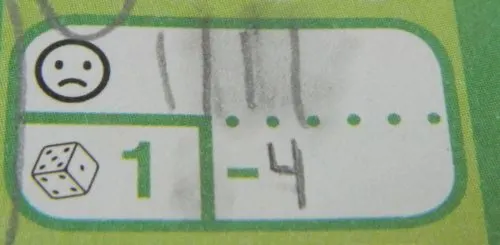In recent years Gamewright has really started to get into the roll and write genre. The companies most popular game from this genre is probably Qwixx which we took a look at while back. While the whole game consisted of just dice and scoresheets, Qwixx was quite satisfying as it did a good job combining simple gameplay mlechanics with more strategy than you would initially expect. As a fan of the roll and write genre, I was excited to try out one of Gamewright’s more recent entries to the genre Bloom which was released back in 2019. Bloom is not the deepest game, but it succeeds at being a quick and enjoyable game that the whole family can enjoy.
How to Play Bloom
Setup
- Each player will take a random gamesheet and a pen/pencil.
- Place the six dice in the center of the table.
- The player who was most recently given a flower will be the start player.
Playing the Game
Bloom is played over a number of rounds. Each round consists of the following three steps.
- Roll the Dice
- Choose Customers and Make Bouquets
- End a Round
Roll the Dice
The start player will take the six dice and roll them. These six dice will create a shared pool of dice that all of the players will use for the round.
Choose Customers and Make Bouquets
Starting with the start player and moving clockwise, each player will get to choose one of the dice from the table. Once a die is taken by a player, the other players can’t also choose that die. When taking the dice make sure you don’t change the number that was rolled.
Instead of choosing one of the remaining dice, a player can choose to re-roll the remaining dice. Players can only choose this action once during the game. When a player chooses this action they will cross off the corresponding section of their gamesheet. If a player doesn’t use this action during the game, they will score one point at the end of the game.
After choosing a dice each player will then analyze their gamesheet to find the flowers that they would like to circle. The player can circle a number of flowers up to the number on the dice they chose. All flowers that are circled must be adjacent to one another (diagonal does not count). When circling flowers you should try to circle the same number of flowers as the number you rolled as well as flowers that match the color of the die you chose.
The clear die and the white flowers on the gamesheets are considered wild and can match any other colors. For each turn though the clear die/white flowers can only act as one color.
After a player is done circling flowers, they will determine if they have any unhappy customers. A customer will be unhappy if:
- You circle flowers of a color different than the die you chose (white excluded).
- You circle less flowers than the number on the die that you chose.
For each unhappy customer, you will add one mark to the unhappy customer section on your gamesheet. At the end of the game, each of these will be worth -1 point.
End of Round
A round ends when all of the players have taken a die and circled flowers on their gamesheet. In a two player game both players will get to take two dice.
All six dice are given to the player to the left of the previous start player. This player will be the start player for the next round.
Scoring Points
As players are circling flowers on their gamesheet, there are two ways to score points.
When a player circles all of the flowers of a certain color, they will have completed the corresponding bouquet color.
They will circle the highest remaining number for the corresponding color on the right side of their gamesheet. All of the other players will cross off the same number as they won’t be able to score that value anymore.
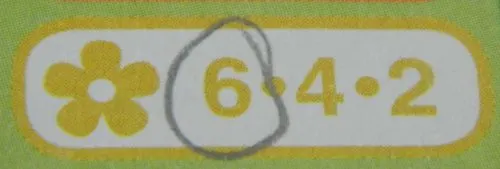
This player was the first to circle all of their yellow flowers so they will circle the six. All of the other players will have to cross off the six from the yellow section of their gamesheet.
All of the flowers are divided into six garden beds. When a player circles all twelve of the flowers in a garden bed, they will circle the lowest garden bed circle remaining on their gamesheet. The other players don’t do anything with their gamesheets.
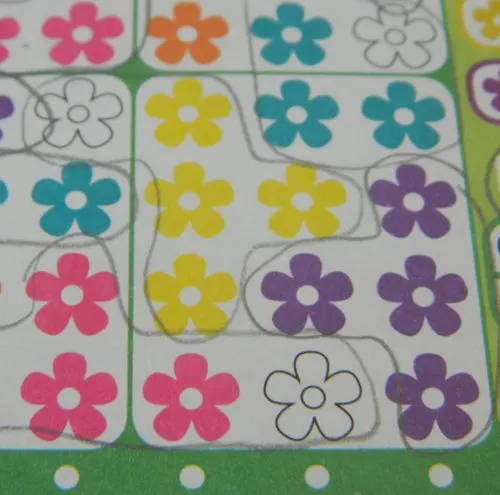
This player has circled all of the flowers in this garden bed. They will circle the lowest remaining number on the garden bed section of their gamesheet.
End of Game
Bloom can end in one of two ways:
- A player has circled three of the color numbers on their gamesheet.
- A player has circled the fourth number in the garden bed section.
The current round will be completed so everyone gets the same number of turns.
Players will then tally up their final score as follows:
- Total the points scored from the numbers circled in the color section.
- Total the points scored from the garden bed section.
- Score one point if you didn’t use the re-roll action during the game.
- Lose one point for each unhappy customer you had during the game.
Players will compare their final scores. The player who scored the most points will win the game. If there is a tie, the tied player with the least unhappy customers will win. If there is still a tie, play another game to break the tie.
Solo Game
In the solo game you try to beat your previous high score.
The rules for the game are mostly the same except for a couple changes.
- The wild/clear dice is not used.
- The highest number of flowers you can circle from each die is four.
- You will take two dice each round.
- The game consists of eight rounds.
- You will record your final score to compare to other games that you have played.
My Thoughts on Bloom
While I generally like roll and write games, one of the main reasons that I was intrigued by Bloom was that it reminded me a lot of Qwixx which is a game that I enjoyed quite a bit. It was made by the same company, Gamewright, and even came in the same small box with a magnetic seal. After playing Bloom I will say that it is not as good as Qwixx, but it is still a good game.
At its core Bloom is very similar to your typical roll and write game. All of the dice are rolled to begin a round with each player having the opportunity to take one die. The number and color of a die that a player takes will determine how many and which color of flowers that a player can circle off their gamesheet. The goal is to circle as many flowers as possible, but any extras will cost you points at the end of the game. Players score points for circling all of the flowers of one color or in one flower bed. The player who scores the most points at the end of the game wins.
If this sounds like a simple game it should as Bloom is a game that is really easy to play. Those who have played similar roll and write games should be able to pick up the game almost immediately. Those that are not as familiar with the genre should still be able to learn the game within a couple minutes. The game has a recommended age of 8+, but I think it could have been a little lower. The game’s simplicity is a real selling point as it is a game that could appeal to people that rarely play board games. This makes Bloom a perfect family game.
With how simple the game is to play, it also means the game plays quite quickly. I would say that most games of Bloom will only take around 15-20 minutes. Having more players or players that have to analyze every option will likely increase the length, but not by too much. This quick length means that Bloom will work great as a filler game. If you don’t have much time or want something easy to break up more difficult games, Bloom will work perfectly. With how short the game is you can also play a quick rematch. When you add in the game’s small portable box, Bloom will work great as a travel game as well.
As Bloom is quite accessible and plays quickly, it would be natural to think that the game doesn’t have a ton of strategy. On most turns it is usually pretty obvious what die you should take as it works well with the flowers that you haven’t circled yet. There will be some turns where you have some decisions to make though. This is because while not a highly strategic game, there is more strategy to Bloom than you would initially expect. I would say that the strategy comes from a couple different areas.
First the game gives you a couple different ways of scoring points. Your points will come from either finishing off colors or garden beds. While you can work towards both at the same time, you likely will end up emphasizing one of them. The colors are more risk/reward in my opinion. If you are the first to complete a color you can score quite a few points from it. If another player beats you to it though, the number of points that you will score will be diminished by quite a bit. Meanwhile the garden beds have no competition as you will score the same number of points no matter how long it takes you to complete them. Until you get to the later garden beds though they will score less points than completing a color. The dice available to you will have an impact on which you prioritize, but having two main ways of scoring points gives you some options in the game.
Another thing that adds some strategy to the game is the idea of unhappy customers. Unhappy customers add some risk/reward to the game. Obviously you want to avoid unhappy customers whenever possible, but that will not always be an option. How many you end up with will depend on how you approach taking dice. Will you play the game more cautiously in order to minimize the negative points, but reduce the max number of points that you could score? Or are you willing to take some negative points in order to maximize the number of ways that you end up scoring points? I could see value in both approaches even though you likely will want to play somewhere inbetween.
When choosing a number there seems to be numbers that are better than others. The sweet spot usually seems to be numbers between three and five. Taking a six is nice as it lets you circle more flowers, but it almost guarantees that you will end up with at least one unhappy customer. Meanwhile taking ones and twos severely limit how many flowers you can circle. Hopefully there will be a number and color combination that works perfectly with what you need, but if there isn’t you need to choose one of the two options. Negative points always suck, but it might be worth losing a point or two if it helps you score four or more points. This is especially true as circling incorrect colors is no worse than not using the full number you chose. If you take too high of number you could choose to circle an incorrect flower as you will lose the points anyways. By doing this you could get yourself closer to finishing a garden bed or color which will score you more points than you lost from the unhappy customers. Because of this reason I honestly think the game should have punished players more for their unhappy customers.
It might not appear so at first glance, but Bloom can be a little cutthroat at times. At least with the group I played with, the players were mostly focused on our own sheets as we generally don’t like to mess with one another except when it is necessary. Some players may decide to play the game in another way though. Most players will take dice that will help themselves, but others may consider what the other players need before taking a dice. Thus you could be stuck with a lot of low dice or colors that don’t really work with your sheet. This could lead to you losing some points or limiting the number of flowers that you can circle. This could especially be bad in four and five player games as the last player(s) will have less dice to choose from. The cutthroat mechanics are not bad in Bloom, but I wanted to briefly bring them up as they could have an impact on the game.
While this review is about Bloom, I actually wanted to quickly talk about a Polish game called Bukiet. This might seem kind of random at first, but it turns out that Bloom is pretty much the Americanized version of Bukiet as it was designed by the same person and basically utilizes the same gameplay. There is actually only three main differences between the two games. First the game implements a bonus of -3 points for the player with the most unhappy customers and +3 for the player with the least unhappy customers. The game also eliminates the re-roll mechanic and reduces the number of points that are scored from the color section. I mostly wanted to bring up the original game since these changes to the rules could easily work as variant rules for Bloom. I honestly don’t know why they weren’t included as official variant rules for Bloom. In particular I am curious about implementing the -3/3 bonus points as it would reward players that avoid receiving unhappy customers. The next time I play the game I really want to try out this variant.
I genuinely had fun playing Bloom as it is pretty much what you would expect from a simple roll and write game. If you want a simple game that you don’t have to put too much thought into what you are doing, I think it is the type of game that you should look into. That said, Bloom is not the deepest game as it is pretty much what you would expect it to be. The strategy is not particularly deep as the game relies on a decent amount of luck between the dice rolls and what dice the other players decide to take. Therefore if you generally prefer highly strategic games, Bloom probably won’t be for you.
Before wrapping up I wanted to quickly talk about Bloom’s components. Like a lot of roll and write games, the components are kind of limited. You basically get six dice and a number of game sheets. In a way it doesn’t feel like you get a lot in the game. The game sheets look nice and you get quite a few in the game, but I kind of wish that the game instead came with dry erase boards as I have always hated paper sheets since when you run out of sheets you will have to find replacements. Otherwise the dice are nice, but nothing special. While the game doesn’t come with a lot of components, it does mean that the game retailed for a pretty low price which offsets most of these problems. As I mentioned before the game also comes in a small box which is great for storage or traveling.
Should You Buy Bloom?
In a lot of ways Bloom is pretty similar to what you would typically expect from the roll and write genre. The game is really easy to play as you basically just roll dice and choose one in order to circle some of the flowers on your gamesheet. This makes the game really quick to play and a perfect filler game. Bloom even has a decent amount of strategy. Your best option is usually obvious, but with multiple ways of scoring points your decisions have an impact on how well you will do. The game won’t appeal to people that want a highly strategic game, but I think it will work great as a family game. The game’s components are kind of limited, but with the game’s low retail price it isn’t a big issue.
My recommendation for Bloom comes down to your feelings towards simpler games from the roll and write genre. If you don’t really care for these type of games, it likely won’t be for you. If Bloom’s premise intrigues you though, I think you will enjoy it quite a bit and should consider picking it up.
Buy Bloom online: Amazon, eBay
. Any purchases made through these links (including other products) help keep Geeky Hobbies running. Thank you for your support.

